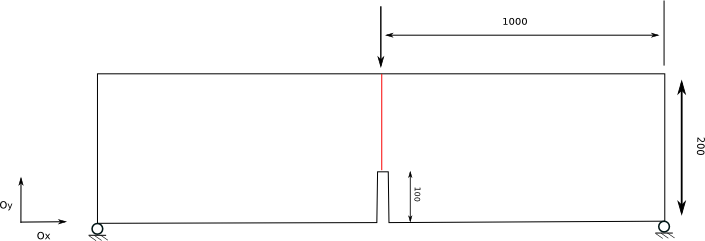1. Reference problem#
1.1. Geometry#
To validate the cohesive law CZM_EXP_MIX, which is more specific to almost fragile materials, we model a notched concrete beam subjected to 3-point bending, based on the experimental data from the thesis of P.-E. Peterson [bib1]. This test is in fact one of the most frequent experimental references for validating models of surface or volume damage of concrete.
A beam of length \(2m\), height \(200\mathit{mm}\) and thickness \(50\mathit{mm}\), notched in the middle on \(100\mathit{mm}\) (half the height of the beam) is simply supported on its two ends.

Interface elements (60 QUAD4)
Figure 1: Representation of the 3-point bending beam. The thickness is \(50\mathit{mm}\)
1.2. Material properties#
1.2.1. The law used is law CZM_EXP_MIX.#
Material parameters are defined under the keywords RUPT_FRAG or RUPT_FRAG_FO
Young’s module: \(E=30\mathit{GPa}\)
Poisson’s ratio \(\nu =0.2\)
Critical surface energy density \({G}_{c}\): |
GC= 137 N/m |
critical stress \({\sigma }_{c}\): |
SIGM_C = 3.3 MPa |
Penalization of the Lagrangian |
PENA_LAGR =300 |
Slip stiffness |
RIGI_GLIS =10 (by default) |
1.3. Boundary conditions and loads#
Embed: The movements imposed following Oy are zero at the 2 support points (GROUP_NO: CL1 and CL2). We block the next 0x movement on one of the two supports.
Displacement: An imposed displacement following Oy is applied above the crack (GROUP_NO: Dpl).